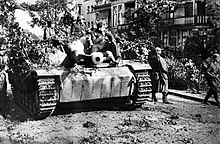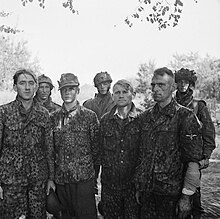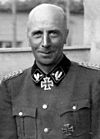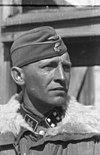9th SS Panzer Division Hohenstaufen
| 9th SS Panzer Division Hohenstaufen | |
|---|---|
| Commanders | |
| Notable commanders | Wilhelm Bittrich Sylvester Stadler |
The 9th SS Panzer Division "Hohenstaufen" (
Formation and Eastern Front
The SS Division Hohenstaufen was formed, along with its sister formation
After the encirclement of General
Western Front
Normandy
Hohenstaufen suffered losses from Allied
After the launch of the Canadian Operation Totalize, Hohenstaufen avoided encirclement in the Falaise pocket and kept the narrow escape route from this pocket open. By 21 August, the Battle of Normandy was over, and the German forces were in full retreat. Obersturmbannführer Walter Harzer was placed in command of the division. It fought several rearguard actions during the retreat through France and Belgium and in early September 1944, the exhausted formation was pulled out of the line for rest and refit near the Dutch city of Arnhem.[5] By this time, Hohenstaufen was down to approximately 7,000 men, from 15,900 at the end of June.

Arnhem
Upon arriving in the Arnhem area, the majority of the remaining armoured vehicles were loaded onto trains in preparation for transport to repair depots in Germany. On Sunday, 17 September 1944, the Allies launched

Bittrich ordered Hohenstaufen to occupy Arnhem and secure a vital metal girder bridge (later torn down, rebuilt in concrete and named
Ardennes Offensive
After the battle of Arnhem, Hohenstaufen moved to
When the attack in the north stalled, the division was sent south to assist in the attacks on Bastogne, where it took heavy casualties from the American defenders and lost much of its equipment to Allied ground attack aircraft. On 7 January 1945, Hitler called off the operation and ordered all forces to concentrate around Longchamps, Belgium.
Hungary and surrender
Throughout the rest of January 1945, Hohenstaufen retreated to the German border. At the end of the month, the division was transferred to the Kaifenheim-Mayen area to be refitted. At the end of February, the division was sent east to Hungary as a part of the reformed 6th SS Panzer Army under Sepp Dietrich.[5] The division, along with the majority of the SS Panzer units available, was to take part in Operation Spring Awakening, the offensive near Lake Balaton, which was aimed at relieving the forces encircled in Budapest by the Red Army.[21]
The attack got under way on 6 March 1945. Due to the condition of the roads, the division had not reached its jump-off position when the attack began. A combination of mud and stiff Soviet resistance brought the offensive to a halt and on 16 March a Soviet counter-offensive threatened to cut off the 6th SS Panzer Army. Hohenstaufen was involved in the fighting to escape the Soviet encirclement.[22] During these actions, Hohenstaufen destroyed 80 Soviet T-34 and IS tanks.[22] On 1 May, the greatly depleted division was moved west to the Steyr–Amstetten area. On 8 May 1945, Hohenstaufen surrendered to the Americans.[5]
Commanders
| No. | Portrait | Commander | Took office | Left office | Time in office |
|---|---|---|---|---|---|
| 1 | SS-Obergruppenführer Wilhelm Bittrich (1894–1979) | 15 February 1943 | 29 June 1944 | 1 year, 135 days | |
| 2 | SS-Standartenführer Thomas Müller (1902–?) | 29 June 1944 | 10 July 1944 | 11 days | |
| 3 | SS-Brigadeführer Sylvester Stadler (1910–1995) | 10 July 1944 | 31 July 1944 | 21 days | |
| 4 | SS-Oberführer Friedrich-Wilhelm Bock (1897–1978) | 31 July 1944 | 29 August 1944 | 29 days | |
| 5 | SS-Oberführer Walter Harzer (1912–1982) | 29 August 1944 | 10 October 1944 | 42 days | |
| (3) | SS-Brigadeführer Sylvester Stadler (1910–1995) | 10 October 1944 | 8 May 1945 | 299 days |
Organisation
Structure of the division:
- Headquarters: Berlin-Lichterfelde
- 9th Panzer Regiment
- 19th SS Panzergrenadier Regiment
- 20th SS Panzergrenadier Regiment
- 9th SS Panzer Artillery Regiment
- 9th SS Panzer Reconnaissance Battalion
- 9th SS Panzer Tank Destroyer Battalion
- 9th SS Panzer Assault Gun Battalion
- 9th SS Panzer Engineer Battalion
- 9th SS Panzer Signal Battalion
- 9th SS Panzer Anti-Aircraft Battalion
- 9th SS Panzer Rocket Launcher Battalion
- 9th SS Panzer Divisional Supply Group
War crimes
Heinz Hagendorf, a medical NCO, was prosecuted at the
In 1946, Markus Lienhart, a lieutenant, was prosecuted for the murders of three American airmen in Straßgang, Austria, in March 1945. After their planes were shot down, the airmen had surrendered. An SS officer, Wilhelm Schweitzer, arrived and ordered one of police officers escorting the airmen to kill them. After the officer refused, Markus arrived and personally shot two of the airmen. The other airman was assaulted by Markus's father, Franz Lienhart. However, the attack was interrupted by an air raid. Afterwards, the airman was handed over to the SS and shot by unknown men.[24]
Markus was found guilty of shooting the two airmen and sentenced to death. Franz, who was also prosecuted, was found guilty of assaulting the third airman and sentenced to 10 years in prison with hard labour. Markus was hanged in Salzburg on 26 October 1946. Due to crippling injuries that he suffered from an accident while in custody, Franz's sentence was reduced to three years. He died in 1957.[24] Schweitzer was put on trial in 1948, found guilty of war crimes, and sentenced to death. However, in light of the controversy surrounding the Malmedy massacre trial, and that Markus Lienhart appeared to have shot two of the airmen entirely of his own volition, Schweitzer's sentence was commuted to life in prison. He was released in the 1950s, and died in 1993.[25][26]
See also
References
Notes
- ^ Official designation in German language as to "Bundesarchiv-Militärarchiv“ in Freiburg im Breisgau, stores of the Wehrmacht and Waffen-SS.
Citations
- ^ Reynolds P.3-312
- ^ Reynolds P.1
- ^ Reynolds P.2
- ^ Reynolds P.4,90,262
- ^ a b c d e f g h i Windrow & Burn, p.15
- ^ DiNardo, p.37
- ^ Ripley, pp. 181–182
- ^ Ripley, p. 182
- ^ a b Reynolds P.11
- ^ a b Reynolds P.12
- ^ a b c Reynolds P.17
- ^ Reynolds P.43
- ^ Reynolds P.52
- ^ Reynolds P.48,49
- ^ Reynolds P.66-81
- ^ Reynolds P.67
- ^ a b Reynolds P.72
- ^ a b Reynolds P.77
- ^ "ParaData.org.uk". AERIAL RECONNAISSANCE PHOTOGRAPH OF THE WRECKAGE AT ARNHEM BRIDGE AFTER THE BATTLE. 1 October 1944. Retrieved 16 June 2024.
- ^ LoFaro G., “The Sword of St. Michael: The 82nd Airborne Division in World War II” 2011, p. 481
- ^ Reynolds P.262-277
- ^ a b Reynolds P.284-285
- ^ "United States v. Hagendorf, Judgment, N/A (U.S. Intermed. Gov. Ct. (Dachau, Germany), Aug. 09, 1946)". www.worldcourts.com. Retrieved 4 October 2022.
- ^ a b Youngs, Kelvin. "Aircrew Remembered Aviation Personal Histories and Databases". Aircrew Remembered site (in Ukrainian). Retrieved 4 October 2022.
- ISBN 978-90-8964-489-3.
- ^ "Schweitzer, Willi 'Tuck' (Waffen SS) - TracesOfWar.com". www.tracesofwar.com. Retrieved 4 October 2022.
Bibliography
- DiNardo, R L (1997). Germany's panzer arm Issue 166 of Contributions in military studies. Greenwood Publishing Group. ISBN 0-313-30178-6.
- Ripley, Tim (2004). The Waffen-SS At War: Hitler's Praetorians 1925-1945. Zenith Imprint. ISBN 0-7603-2068-3.
- Windrow, Martin; Burn, Jeffrey (1992). The Waffen-SS Volume 34 of Men-at-arms series. Osprey Publishing. ISBN 0-85045-425-5.
- Paras: An Illustrated History of Britain's Airborne Forces by David Reynolds
- Reynolds, Michael (2002). Sons of the Reich : 2nd SS Panzer Corps. Barnsley: Pen & Sword. ISBN 9781848840003.




